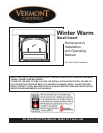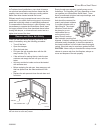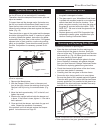
6
WinterWarm Small Insert
2000888
A,I
B
C
D,
J
E
D,J
H
C
E
FP1084
winterwarm
fireplace minimum dimensions
3/01
Fireplace Minimums
A. Width at Face 26¹⁄₂” (673mm)
B. Width at
9” depth 26
¹⁄₂” (673mm)
C. Depth
1
14¹⁄₂” (370mm)
D. Height at Face 21
¹⁄₂” (540mm)
E. Height at
15¹⁄₂” depth 21¹⁄₂” (540mm)
FP1084
Fireplace Maximums
H. Lintel depth 9¹⁄₂” (240mm)
I. Width
2
44¹⁄₂” (1130mm)
J. Height
2
31” (770mm)
1. The minimum depth must be maintained from the floor of the
fireplace to a height of 21
¹⁄₂” (540mm)
2. Though the WinterWarm Small Insert will fit into larger fireplaces,
the decorative optional CFM Corporation Surround Panels will not
completely cover the fireplace opening if these dimensions are
exceeded. Custom made trim pieces may be used.
Fig. 3 Use these measurements to confirm that the Winter-
Warm Small Insert will fit into your masonry fireplace.
Clearance Requirements
After confirming that your fireplace is the right size,
check the clearance to combustibles. First mark with
tape the exact center of your fireplace opening on the
hearth. Measure the side clearance from this point.
Measure the top trim and/or mantel clearances from the
finished hearth surface. Measure the front clearance (to
furnishings, etc.) from the fireplace face. (Fig. 4)
X
FP1085
WinterWarm
clearances
3/01
C
A
B
Measure
side trim
clearance
from here
FP1085
Fireplace Clearances
A. Mantel* 34” (865mm)
B. Top Trim* 34” (865mm)
C. Side Trim** 20¹⁄₈” (510mm)
* for more details on mantel and top trim, see Note below.
** Where side trim extends more than 2” (50mm) from the
fireplace facing, the side clearance must be no less than 20
⁵⁄₈”
(525mm).
Measure the side clearance (C) from the exact center of your fire
-
place opening on the hearth (X). Measure the top trim (B) and/or
mantel clearances (A) from the finished hearth surface. Measure
the front clearance (to furnishings, etc.) from the fireplace face.
Fig. 4 Observe these clearances to combustible trim.
Hearth Requirements
In some fireplaces, the hearth in front of the fireplace
opening is brick, stone, slate, or some other non-com-
bustible material that is in direct contact with concrete
poured over earth. These are the only hearths that are
considered noncombustible. In other fireplaces, the
brick or concrete hearth in front of the fireplace opening
is supported by heavy wooden framing. Because nei-
ther brick nor concrete has good insulating properties,
heat radiated by the fire will pass downward through
the hearth to the wooden framing. Such hearths are
considered combustible.
Unless the fireplace and hearth are constructed over a
completely non-combustible surface (such as unpainted
concrete over dirt), a floor protector must be used
in front of and to the sides of the door as protection
against spilled coals and embers. Floor protectors must
extend at least 8” (203mm) from the side of the door
opening, making the protector 41” (1041mm) wide. In
addition, the floor protector must extend from the front
door opening a minimum of 16” (406mm) in the United
States and 18” (457mm) in Canada. (Fig. 5)


















